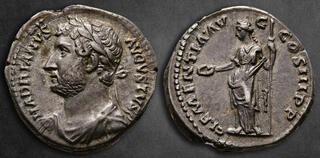| Savoca Numismatik GmbH & Co. KG > Online Auction 203 | Silver | Auction date: 24 March 2024 |
| Lot number: 472 Price realized: 550 EUR (Approx. 597 USD) Note: Prices do not include buyer's fees. | Show similar lots on CoinArchives Find similar lots in upcoming auctions on |
| Lot description: Hadrian AD 117-138. Struck 129 - 130 AD.. Rome Denarius AR 19 mm, 3,11 g HADRIANVS AVGVSTVS, draped cuirass bust with laurel wreath left. / CLEMENTIA AVG COS III PP, Clementia standing left with patera and scepter. Fine toning, Near Extremely Fine. RIC 1070; RSC 221a; C. 221; Strack 333. This Hadrianic denarius, minted in Rome between 129 and 130 AD, encapsulates significant elements of Roman culture, imperial ideology, and the personal propaganda of Emperor Hadrian. The coin serves as an important artifact, shedding light on the themes of governance, divinity, and public image that pervaded Hadrian's reign, contributing to our understanding of this period. The obverse of the coin presents "HADRIANVS AVGVSTVS," signifying Hadrian as the Augustus, the revered emperor. The portrayal of Hadrian with a draped cuirass and a laurel wreath facing to the left not only exemplifies the conventional Roman virtues of strength and martial prowess (as indicated by the cuirass) but also divine favor and victory (symbolized by the laurel wreath). The left orientation of the bust may have specific significance, possibly reflecting a moment or attribute specific to Hadrian's reign, although interpretations vary. This side of the coin establishes Hadrian's authority and divine endorsement, integral to the Roman imperial cult. On the reverse, the coin features the goddess Clementia, an embodiment of clemency and mercy, standing with a patera (a sacrificial dish) and a scepter. The inscription "CLEMENTIA AVG COS III PP" not only identifies the figure but also emphasizes Hadrian's roles and titles. By associating himself with Clementia, Hadrian claims the virtues of mercy, leniency, and fairness as central to his rule. This association was particularly important in maintaining the loyalty and affection of the Roman populace and the provinces, promoting a peaceful and stable society under his governance. The coin falls within the broader context of Hadrian's extensive travel throughout the Roman Empire, his legal reforms, and his efforts to consolidate and stabilize the empire's frontiers. By showcasing these virtues and divine associations on his currency, Hadrian was able to communicate his image and ideals directly to the vast and diverse population of the empire. The denarius, as a widely circulated coin, played a crucial role in the everyday transactions of Roman citizens, making it an effective medium for imperial propaganda. The fine toning and near extremely fine condition of this particular coin suggest it was held in high regard, possibly treasured by its ancient owners as much as by modern collectors. Furthermore, the specific references to Hadrian's third consulship (COS III) and his paternal role towards the people (P P for "Pater Patriae," or Father of the Country) reinforce his image as a benevolent and protective leader, aligning his public persona with the ideals of Roman governance and virtue. In summary, this Hadrianic denarius is not merely a piece of ancient currency but a symbol of the intricate relationship between emperor and subjects, divine favor, and the virtues of governance. It reflects the personal branding of an emperor who was deeply aware of the power of image and the importance of public perception, making it a valuable piece of history from one of Rome's most fascinating periods. Starting price: 500 EUR |  |


